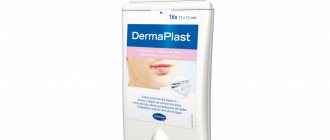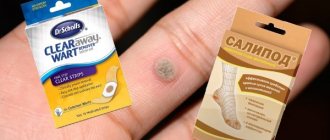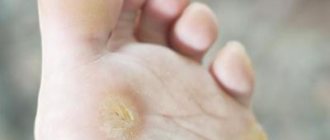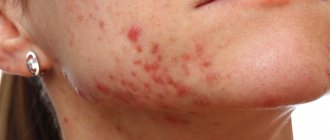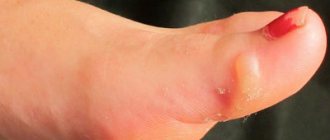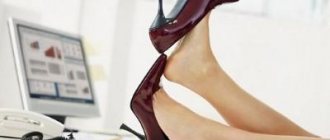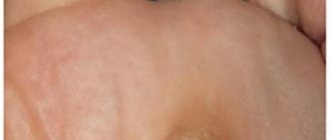Calluses or hyperkeratoses are local changes in the skin associated with exposure to damaging factors on an area of the body.
Literally translated, “hyperkeratosis” means “excess of keratin,” a substance that causes hardening.
The skin loses its elasticity, becomes less sensitive to external influences, and feels rough to the touch.
Defects in ICD10 are allocated to a special nosological group L84 - “Calls and calluses”.
Mostly calluses form on the skin of the hands and feet, where the epidermis (skin) contains, among others, a shiny layer.
It provides increased skin density as an adaptation to external pressure or friction.
As a result, the skin becomes denser in defense and calluses form.
Classification of calluses
A dry callus is a limited area of yellowish, keratinized, thickened, dense skin.
Painful when located at the base of the fingers on the plantar or palmar surface.
Calluses on the heels lead to the formation of cracks, which can become painful and become infected.
Causes of dry calluses:
- work in a standing position
- long walk
- tight and narrow shoes
- working with tools (construction, musical, sports, power tools)
- dry skin where calluses form
- thinning of subcutaneous fat in areas where calluses form
A soft callus—otherwise known as a wet callus—is saturated with moisture and softens, forming blisters.
Microtraumas cause inflammation with damage to the deep layers of the skin.
Under the pressure of the released interstitial fluid, the surface epidermis rises.
Moisture sweats inside and bubbles form.
A typical place for the formation of such calluses is the interdigital folds.
Such calluses cause extreme pain and are dangerous when the bladder is opened due to the risk of infection.
Causes of soft calluses:
- microtraumas and cracks
- wet skin where calluses form
- thinning of the skin and subcutaneous fat
- tight shoes or tight wet gloves
- wet socks or stockings
- increased sweating of the feet
- thinning of the skin and infection
A core (or “ingrown”) callus is a dense, round area of hyperkeratosis.
With clear boundaries and a hard transparent whitish rod in the center, when viewed it resembles a lid.
They are formed in response to injury by a foreign body (stone, splinter) in places where bone bases press on soft tissue.
The rod consists of a stratum corneum, as hard as a nail plate.
Therefore, when vertical pressure is applied to the callus, severe pain is felt due to compression of the dermal nerves.
Callus must be distinguished from plantar warts, since the treatment indicated is different.
A plantar wart is similar in appearance to a callus, but its surface looks loose, with brown dots.
And pain appears with any pressure, including from the sides.
There is usually only one core callus, and small, daughter similar formations form next to the large wart.
Causes of callus formation:
- high heels shoes
- work in a standing position
- untreated soft callus
- viral and fungal infections
- microtrauma of the skin
- constant pressure or rubbing of a specific area of skin
- diabetes
- flat feet
Subungual keratosis, in which the nail folds appear as thickenings on the side of the nail plate in the form of a dense yellow-gray mass.
The nail becomes dense, dull, deformed, and partially destroyed on both sides.
Such formation may indicate a fungal infection of the nail.
Therefore, you should see a mycologist, as well as the development of panaritium or an ingrown nail.
Reasons for the formation of subungual keratosis:
- failure to comply with hygiene rules
- diabetes mellitus (diabetic foot)
- violation of the trophism of the skin of the feet
- nail phalanx injuries
Corns are areas of hardened skin on the plantar surface of the foot.
Causes of corns formation:
- tight shoes with insufficiently rigid and thin soles (calluses in the heel area)
- high heels (corns in the big toe area)
- displacement of the center of gravity with valgus or varus position of the feet (corns on the lateral surface of the foot)
- Reduced spring function of the foot due to flat feet (calluses all over the sole)
Children more often develop soft (“wet”, “weeping”) calluses that look like a bubble with liquid.
Reasons for the formation of a soft callus with a blister in children:
- Tight shoes
- Shoes with rough seams, made of leatherette
- Shoes that are too big (not the right size)
- Large socks or tights that bunch up when wearing shoes
In women, soft (“wet”) calluses are more common on the upper extremities when working in their summer cottage or in places where they are compressed by tight shoes.
Often, core and dry types of calluses appear as a result of constant pressure or friction.
For example, when working with sports (stick, dumbbells, barbells, clubs) or athletic (mechanical and electrical simulators) equipment.
Or when constantly carrying heavy loads.
Dry calluses are common among musicians, in particular on the fingers of a guitarist or calluses on the fingers and chin of a violinist.
Older people can develop all types of calluses.
Age-related dry skin stimulates the formation of dry calluses and corns.
Thinning of the skin leads to cracks and the formation of wet calluses; ingrown toenails are formed due to poor foot hygiene against the background of subungual keratosis.
Painful sensations and impaired sensitivity of the feet lead to the risk of falls in an elderly person, or even refusal to walk.
With a long course of the disease, bedsores may appear on the feet.
News
Hydrocolloid patches provide the wound with a moist environment that speeds healing and prevents the formation of unsightly scars. See what hydrocolloids are and what their properties and uses are. Learn when and how to use hydrocolloid dressings and how to choose the best and most suitable for your needs.
What are hydrocolloid patches?
Hydrocolloid patches belong to the group of modern active dressings that not only protect the wound and isolate it from external factors, but also actively influence its internal environment. They are mainly used on wounds with slight or moderate exudate:
- in the final stage of the cleaning phase;
- on the threshold of the proliferative phase, during which the body begins to restore torn or destroyed tissue;
- when the skin splits with a blister.
Traditional dressings dry out the wound, which leads to the formation of a scab under which the healing process occurs. After its removal, a scar remains. A humid environment has a positive effect on the growth of epidermal cells. In a dry environment this phenomenon also occurs, but much more slowly.
What are hydrocolloids? Hydrocolloids are high molecular weight chemical compounds, biopolymers of natural or synthetic origin. They are characterized by very high solubility in water. They absorb moisture, enclosing it in the structure of the resulting gel.
Colloids are substances that consist of at least two components. They are connected to each other in an interesting way - at the molecular level, one substance penetrates into another. There are also colloids consisting of 3, 4 or more substances that combine with each other according to the same principle.
The most common colloid in everyday life is milk, which looks like a liquid (mixture), but when left in a warm place, it begins to separate into whey and curd - colloidal components. A common medical colloid is carboxymethylcellulose, in which, under conditions of increased temperature of the wound and exudate, the process of delamination begins, and it covers the wound with a thick, fatty-gel mass.
How do hydrocolloid patches work on wounds? Hydrocolloid wound patches act actively and multidimensionally. They speed up the healing process, especially supporting the granulation phase, and also provide adequate protection against dirt, bacteria and mechanical trauma. Hydrocolloid patches:
- absorb the effusion coming out of the wound, then “sealing” it in the form of a gel. Thus, they contribute to effective wound cleansing;
- acidify the wound environment, creating favorable conditions for phagocytic granulocytes, and therefore prevent the proliferation of bacteria;
- provide proper moisture to the wound, preventing it from excessive drying and creating an ideal climate for fibroblasts and, therefore, skin cells involved in the process of repairing damaged tissue in the proliferation phase;
- represent a physical barrier that protects the wound from the effects of the external environment. In addition, thanks to the durability of the materials from which the patches are made, dressing changes can be carried out much less frequently than with traditional means and, above all, less painful - due to the preservation of moisture.
Hydrocolloid patches for heels and calluses
Hydrocolloid patches are used mainly for various types of open wounds, especially post-traumatic ones, but in practice the list of their uses is wider. More and more people are using this type of bandage for their feet and elbows, which tend to be prone to peeling and painful cracking.
Hydrocolloid patches for heels:
- increase humidity levels in sensitive areas,
- soften dead skin,
- allow you to remove excess dead skin,
- accelerate the restoration of healthy tissues,
- significantly reduce the level of pain, facilitating daily functioning.
Good hydrocolloid bandages for heels and elbows should have an anatomical, specially cut shape that ensures a tight fit to very rounded parts of the body. This prevents them from peeling off and also helps to obtain the desired healing effect.
Hydrocolloid callus patches are also sold that absorb fluid from the callus and turn it into a gel. They provide pain relief by covering the wound and relieving pressure on the skin. This type of bandage is “unobtrusive” and comfortable. They allow the skin to breathe, provide a moist healing environment and are very easy to use.
Let's summarize Bimed Premium hydrocolloid plasters are made from a unique transparent self-adhesive hydrocolloid mass. Coming into contact with the callus fluid, the hydrocolloid mass forms a protective cushion that insulates the wound from pressure and friction. By absorbing fluid from the callus, it creates ideal conditions for healing.
Thanks to this unique material, Bimed hydrocolloid plasters perform a number of the following functions: - they are moisture resistant, which allows contact with water; - maintain the natural moisture level of the callus, promoting favorable healing; - reduce pain from wet calluses; - protect calluses from rubbing and avoid infections; — have increased gluing reliability, last more than 24 hours; - provide rapid healing of the skin.
Hydrocolloid patch is much more effective than regular patch. Like a real “second skin,” Bimed Premium for wet calluses accelerates the healing process and provides a comfortable feeling.
Be healthy!
Republic of Belarus, Minsk, Lynkova st., 123b +375 (17) 250-05-88; +375 (17) 365-15-88; +375 (29) 646-43-49; [email protected] bimed.by
How to treat calluses at home
The best way to treat calluses at home, without involving a doctor, is to use special patches.
Pharmacies often offer a variety of products targeting different types of calluses.
Each patch has instructions included in the packaging or printed directly on it.
Mode of application:
- The limb should be lightly steamed and blotted dry.
- Lubricate the healthy part of the skin around the callus with baby cream or Vaseline.
- Remove the protection, place the membrane impregnated with the medicinal composition strictly on the skin defect
- Fix the patch and wear for 1-2 days
Patches for dry calluses
Patches often used for dry calluses should contain emollients and moisturizers and substances: urea or salicylic acid.
A patch with salicylic acid eliminates the stratum corneum, relieves local inflammation, and prevents the development of cracks.
The use of the patch in patients with allergic reactions is possible only after consulting an allergist.
The Leiko dry calluses patch is a fabric strip with a membrane impregnated with salicylic acid.
The application time for one patch is 2 days.
The Urgo salicylic patch features a foam pad that protects healthy skin from the effects of salicylic acid.
Perforation ensures the prevention of the “greenhouse effect”, preventing macerations.
Time to use the patch is 24-48 hours.
A clear disadvantage of the product is the risk of allergic reactions.
Hands remain a little sticky after use due to the adhesive base of the patch.
Salicylic acid is found in Chinese Jiyantie and Shulyangsuan patches along with phenol.
Has an antiseptic, softening, analgesic effect.
The use of patches in patients with diabetes and children is excluded due to high concentrations of active substances.
Plasters for dry calluses and corns are manufactured by the following companies:
- Dr. House
- Johnson & Johnson (Compeed dry callus patch)
- Hartmann (Cosmos patch for dry calluses)
Compeed and Cosmos foot callus patches have a translucent texture.
This allows them to be used on the hands, face, back of the foot, little finger).
In addition to softening, the patch provides an environment that stimulates active division and growth of new epidermal cells.
Luxplast spray patch is most often used for soft calluses.
But it is able to create a protective film that protects dry callus from further friction.
You can also use Foretal Plus cream, containing 25% urea in combination with phospholipids.
Foot pathologies
Spinal diseases begin from the feet! Therefore, it is very important to ensure that your feet are healthy. Despite its external primitiveness and our usual purpose - “to walk,” the foot has a much more complex structure and tasks. Just imagine, this body part has 28! bones connected to each other by joints of different density and mobility. For comparison, the spine has 32-34 vertebrae. A little more than one foot!
Its complex structure allows it to fully perform its functions:
- ensuring upright posture
- softening of dynamic and static loads during running and walking (shock absorption)
A modern upright person walks most of the time in shoes (and, in pursuit of style and fashion, not always comfortable), and more often on smooth surfaces ( massage mats
and barefoot jogging over rocks will help). Under such conditions, the feet inevitably become distorted. Joint movements are limited and biomechanics are disrupted. And this process starts from early youth and lasts throughout life. The result is heel spurs and bunions, flat feet, corns and calluses.
Where do grown bones and curvatures come from?
The first thing that comes to mind when it comes to the causes of foot pathologies is bad shoes. And this is the most popular answer. But it’s not just tight shoes and high heels that affect the condition of your feet. Joint problems arise for several reasons:
- The inherited structure of the foot.
- Acquired diseases: bursitis, flat feet, arthritis, osteoporosis, metabolic diseases, polio.
- Excess body weight increases the load on the bones of the foot.
- Injuries.
- Undeveloped, weak ligaments and muscles of the lower legs.
By ignoring the signals from your feet, you risk developing more serious joint problems. And if you have neither the strength nor the will to give up heels, then orthopedic correctors
, which (especially in the summer) should be made your daily ritual.
Plasters for core calluses
For core calluses, the choice is usually the Salipod patch.
It contains salicylic acid, precipitated sulfur, lanolin and natural rubber.
A fragment is manually cut out of the patch, the shape and diameter corresponding to the callus core.
It is applied to it and secured on top with an adhesive plaster for 48 hours.
If there is no effect, Salipod is reused.
This patch is very effective, but has a number of contraindications.
These are pregnancy, early childhood, allergic reactions, open wounds and moles at the site of callus formation, elderly and senile age, diabetes mellitus.
Care must be taken not to allow the Salipod patch to attach to healthy skin: burns are possible.
Compeed and Cosmos patches are used for ingrown calluses.
They are made using hydrocolloid “second skin” technology, which prevents infection after removal of the rod.
Patches for soft (wet) calluses
The patch is aimed at preventing wound infection, protecting damaged skin, resolving blisters and relieving pain.
Such patches are made from hydrocolloid materials that act like a “second skin.”
It is strictly contraindicated to open the blisters on your own.
This leads to infection and, upon healing, to disfigurement of the skin area.
If the bubble has opened, the skin around the wound is treated with hydrogen peroxide or furatsilin solution.
A medical plaster or self-adhesive bandage with a bactericidal effect is applied to the wound.
Compeed (manufactured by Johnson & Johnson) and Cosmos (manufactured by Hartmann) patches are made from colloidal substances that promote healing.
Plaster Dr. House has a hydrocolloid pad.
The application time for one patch is 24 hours.
Luxplast spray patch for wet calluses creates a hydrocolloidal waterproof protective film by spraying, drying within 30 seconds.
Apply once a day until the wound is completely healed.
Used in the treatment of wet calluses in children.
Liquid patches Emplasto, Gehwol (gel patch - callus pencil) are applied to the skin, forming a protective film.
The liquid patch contains mild astringents and antiseptics; it can be applied even to a child.
The best creams for calluses
Callus cream is mainly used to soften thickened skin as well as dry calluses. It contains a small concentration of active components, so the compositions are best used for prevention or therapy, but in unadvanced forms. Can be used as a cream for daily foot care.
The best creams for calluses:
AQUAPILING
It's a cream, but the consistency is more like a paste. A distinctive feature of the composition is the high concentration of active ingredients. The formula contains up to 40% urea, so the composition belongs to medicinal cosmetics. Since the concentrated product is used very sparingly, it comes in compact tubes that are convenient to carry in the pocket of almost any clothing. Using callus cream, you can soften even very hard calluses in just 1-2 applications. The main advantage of the product is its pronounced therapeutic effect.
| Characteristic | Meaning |
| Volume | 20 ml |
| Compound | Urea, green tea extract, chamomile extract |
Pros:
- softens the skin well and deeply;
- most calluses and corns go away within 1 week of use;
- removes the effect of rough skin;
- pleasant lavender scent;
- lasts a long time.
Minuses:
- relatively high price: 230 rubles for 20 g;
- It takes a long time to absorb, you need to lie down for at least 5 minutes.
Review: “I recommend buying it not only to eliminate corns or calluses, but also to treat cracked heels. I had deep cracks, I started using it and voila - they disappeared, but within 2 weeks. I use it all the time, this never happens again.”
911+ Callus
A special and highly effective cream that fights dry calluses and corns. Thanks to salicylic acid and urea in the composition, the product quickly and deeply penetrates the skin, softening rough calloused formations. It helps to get rid of compactions in the dermis quite simply; it itself begins to gradually peel off with regular use. Tea tree oil and marjoram are used as auxiliary components, which provide a bactericidal effect and accelerate the regeneration of healthy, beautiful cells.
| Characteristic | Meaning |
| Volume | 100 ml |
| Compound | Urea, salicylic acid, sulfur, tea tree and marjoram oils |
Pros:
- quickly copes with corns;
- deeply nourishes the skin;
- accelerates the restoration of normal dermis in the problem area;
- removes deep cracks in heels;
- low price.
Minuses:
- specific smell;
- absorbs slowly.
Review: “Quickly and efficiently removes corns. It is enough to apply a thin layer to areas where the skin is often layered and seal with a band-aid. I keep it like this for about 30 minutes, and then rinse it off and remove the residue with a fine-grained grater. Dead scales fly off with a bang, without damaging healthy skin.”
NATURA SIBERICA
The next worthy TOP product is a natural cream from a popular domestic manufacturer, which actively softens the keratinized layers of skin on the feet. This effect is ensured by the natural extract of Yakut sorrel, as well as a high concentration of vitamin C. In order for the epidermis to recover faster and acquire tone, fir oil is used, which additionally disinfects the area and creates a feeling of freshness. Thanks to D-panthenol and beeswax, the skin is deeply nourished, becomes soft, and cracks and wounds heal. At the same time, the product does not clog pores.
| Characteristic | Meaning |
| Volume | 75 ml |
| Compound | Panthenol, wax, Yakut sorrel extract, fir oil |
Pros:
- the skin continues to breathe;
- can be used for both prevention and treatment;
- suitable for massage;
- nice smell;
- absorbs quickly;
- completely natural composition.
Minuses:
- not a very pronounced effect, does not remove very rough corns;
- creates a sticky effect.
Review: “Wonderful cream! True, it’s expensive, but it lasts a long time. If used regularly, it helps get rid of calluses. Tested by me personally."
EPISODE 03 Urea
The basis of the cream is carbamide, which is also called urea. This ingredient deeply moisturizes and softens the skin due to its ability to attract water molecules. Among the auxiliary effects, a soothing effect on the skin was noted, as well as the formation of a protective surface that prevents cracking and drying of the epidermis. Urea is complemented by extracts of celandine and oak bark, which eliminate fatigue and a feeling of heaviness in the legs.
| Characteristic | Meaning |
| Volume | 75 ml |
| Compound | Urea, celandine and oak bark extracts |
Pros:
- light texture;
- pleasant smell, not very pronounced;
- spreads well over the skin;
- affordable price;
- absorbs quickly.
Minuses:
- it doesn’t help everyone, especially in advanced cases;
- creates a film that makes the skin difficult to breathe.
Review: “An excellent cream with a weightless texture that is easy to apply to the skin. I liked it because of the pleasant smell and, of course, the noticeable effect. I bought it as a gift for a friend, now she only uses it.”
FLY AKOMOR VS.
A care cream for rough skin that quickly softens calluses and accelerates natural cell regeneration, promoting the healing of wounds and cracks. It has soothing and moisturizing effects, and also removes irritation and fights peeling. It has an antiseptic effect and deodorizes the feet, especially in the presence of fungal infections. Acts as a prevention of fungus on the lower extremities. With regular use, it reduces foot sweating. Can be used on other areas of the body with increased sweating.
| Characteristic | Meaning |
| Volume | 75 ml |
| Compound | Hyaluronic acid, panthenol, horsetail extract, tea tree and fir oil |
Pros:
- strong effect, especially after a course of use for 2 weeks;
- protects against fungus formation;
- removes irritation;
- accelerates the healing of cracks;
- deeply nourishes and tones the skin.
Minuses:
- dense composition;
- takes a long time to absorb.
Review: “It softens the skin well, even corns become amenable to removal.”
Which plaster for calluses is better?
- the one that is applied to the callus in a timely manner
- corresponds to the type of callus
- Fits tightly and is easy to remove
- does not cause allergic reactions
If the patch for calluses does not provide the required effect, you should contact a podologist or podiatrist, a specialist in therapeutic (medical) pedicure.
A cosmetologist or cosmetology nurse will also help get rid of defects.
In more serious cases, it is necessary to visit a dermatologist, mycologist or simply a surgeon
Rules for choosing callus plasters
When choosing patches, you should look at:
- Availability of special impregnation. It allows you to soften and disinfect the wound, speed up tissue restoration.
- Adhesive base. How long the patch will last depends on its quality.
- Water resistance. An extremely desirable quality, because feet often sweat in shoes. Without moisture resistance, the patch will quickly fall off.
- Size. It is worth choosing based on the size of the callus or corn.
- Type of patch. There are options for dry and wet calluses; they differ in active ingredients and composition features.
The listed remedies for calluses will help get rid of skin compactions, reduce pain and eliminate corns. Creams and patches are the most effective on the modern market, which is why they are recommended to be used for growths on the skin of the feet.
Preventing the formation of calluses
- hygiene of the skin of the feet and hands, timely pedicure
- maintaining sufficient skin hydration
- avoid wet hands and feet (socks, gloves, prolonged exposure of hands and feet to water)
- comfortable shoes that fit well, with a wide toe and a hard heel
- shoes with dense soles with some elevation in the heel area, well-finished edges, smooth insoles
- changing shoes several times during the season
- massage of hands and feet, therapeutic exercises
- thorough treatment of soft and dry calluses, avoiding complications
- avoid microtraumas, including permanent traumatization by a foreign body
- don't cut calluses
- use protective plasters if there is a risk of callus formation
If calluses appear, contact the author of this article, a dermatologist in Moscow with many years of experience.
What are “foot correctors”
Toe correctors are a mandatory life-saving remedy both for the first signs of foot deformation (they allow you to gradually eliminate and maintain the anatomical position of the feet) and for severe disorders (they will not completely eliminate the defects, but will allow you to stop or slow down the processes). Corrective devices allow you to distribute the load on the arches of the feet, protect deformed joints from friction in shoes and injuries, and prevent the formation of calluses and corns
and cracks in the skin, give a stable position to the foot and toes.
When to use foot correctors
These are products for adults who are newly diagnosed or who have been developing various deformities of the foot and toes for a long time (longitudinal, transverse or combined flatfoot, halux valgus, heel spur, etc.), including those with accompanying inflammation (bursitis). Also, these products can be used as a means of preventing these diseases. Especially prevention _
Indicated for lovers of high heels and representatives of professions who experience constant stress on their feet.
Types of orthopedic foot correctors
Gel pads.
Silicone shoe inserts
– an extremely useful acquisition that saves many women. An orthopedic item makes wearing shoes, even with high heels, an easy task. This is especially true in the summer, when shoes are mostly open-topped.
Gel pads help to evenly distribute the load on the foot and have a massage effect. Also orthopedic products for legs
relieve tension in muscle tissue, normalize blood circulation, prevent swelling and minimize the risk of varicose veins. The foot, especially in high heels with an open toe, does not roll forward, since the insert perfectly adapts to the position of the foot. Thanks to this device, the gait takes on a more confident appearance.
The use of silicone insoles is a small contribution to great health.
Protective inter-finger liners and partitions.
The products are fixed between the toes and protect the joints from injury and compression, returning them to their anatomically correct position. With regular use, incipient joint deformation can be completely corrected. Silicone baffles and earbuds
correctly distribute the load on the foot and reduce pressure on the bone.
If you often encounter corns and calluses in the wide part of the foot, then the best solution for you will be protective intertoe barriers that will relieve discomfort.
Abductor bands and splints.
Designed for foot correction
at night or when a person is least active. They are most often used when there is a deformity of the big toe or deviation of the little toe into the foot. Allows you to slow down the development of curvatures and complications.
Orthopedic protectors for foot joints
The function of the protector is to protect the metatarsophalangeal joint from permanent injury. If you have no idea what it is and are sure that you have never encountered discomfort in this area, you are mistaken.
(photo of the metatarsophalangeal joint)
Protectors are made of silicone. The material is able to take the desired shape and size, which makes them universal.
Thumb protectors
or
little toes
also allow you to correctly distribute the load on the feet, preventing calluses, rubbing and injuries to the joints of the feet.
